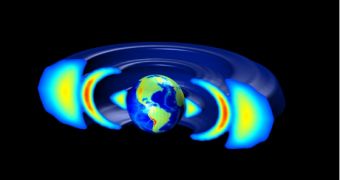UCLA scientists now claim to have solved the mystery surrounding a radiation ring that formed around our planet back in September 2012 and that persisted for about a month.
Writing in yesterday's issue of the journal Nature Physics, the researchers explain that, back in 1958, the scientific community became aware of the fact that planet Earth is encircled by two rings of highly charged particles whose shape resembles that of a doughnut.
These rings are now known as the Van Allen radiation belts, and they are located between 1,000 to 50,000 kilometers (621 miles to 31,068 miles) above our planet's surface.
The inner one is made up of high-energy electrons and energetic positive ions, whereas the outer one comprises high-energy electrons.
By the looks of it, the radiation ring that formed in last year's September was made up of extremely energetic particles dubbed ultra-relativistic electrons. These particles originated in the outer belt, and were driven out of it by ions-induced plasma waves.
As the scientists put it, said waves “whipped out ultra-relativistic electrons in the outer belt almost down to the inner edge of the outer belt.” Whatever high-energy electrons escaped this battering came to form the third ring.
What's interesting is that the ultra-relativistic electrons that were pushed out of the outer belt and that made up the odd third radiation ring around our planet are so energetic that they move close to the speed of light.
“Their velocity is very close to the speed of light, and the energy of their motion is several times larger than the energy contained in their mass when they are at rest,” scientist Adam Kellerman explained.
Unlike ultra-relativistic electrons, those who pack slightly less energy are not usually disturbed by plasma waves. What's more, they respond to low-frequency electromagnetic pulsations, something which the former did not.
“In the past, scientists thought that all the electrons in the radiation belts around the Earth obeyed the same physics. We are finding now that radiation belts consist of different populations that are driven by very different physical processes,” Yuri Shprits with the UCLA Department of Earth and Space Sciences commented on these findings.
“This study shows that completely different populations of particles exist in space that change on different timescales, are driven by different physics and show very different spatial structures,” the researcher went on to say.

 14 DAY TRIAL //
14 DAY TRIAL //